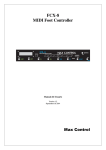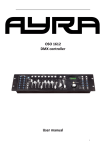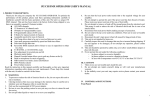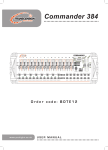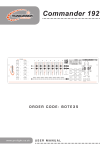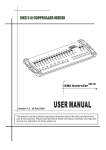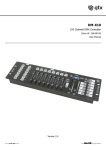Download GALAXY 240C - Prestige LED Lighting
Transcript
GALAXY 240C USER MANUAL DMX 512 CONTROLLER SERIES TABLE OF CONTENTS 1. Summary 3 Product Introduction Content List 3 3 Safety notes 4 2. Safety Information 3. Product diagram 4. Features 5. Operating Instructions Setup Setting Up The System Fixture Addressing Wheel Assignment Review Wheel Assignment Or Reverse Copy Scanner (Example: Copying Scanner 1 Into Scanner 2) Reverse Channel Output Fade Time Assign Operation Manual Mode Review Scene Or Chase Programming Entering Program Mode Create A Scene Running A Program Check Program Editing A Program Copy A Program Chase Programming Create A Chase Running A Chase Checking A Chase Edit Chase (Copy Bank Into Chase) Edit Chase (Copy Scene Into Chase) Edit Chase (Insert Scene Into A Chase) Delete A Scene In A Chase Delete A Chase Delete All Chase Programs Scene Programming (Steps) Insert A Scene Copy A Scene Delete A Scene Delete All Scenes Playback Running In Sound-Mode Running In Auto-Mode Run Multiple Chases Simultaneously Blackout Midi Operation 4 5 8 8 8 8 8 9 10 10 11 11 11 11 12 12 12 13 14 14 14 14 15 15 15 15 16 16 16 16 17 17 17 17 18 18 18 19 19 19 19 20 20 2 Galaxy 240C – User Manual Data Transfer 21 6. Appendix 21 DMX Primer FIXTURE LINKING DMX Dipswitch Quick Reference Chart 7. Technical Specifications 21 22 23 24 1. SUMMARY Thank you for purchasing our LED wall washer. Please read these instructions carefully before operating the system to avoid any possible damage or misuse. PRODUCT INTRODUCTION The DMX-240A is a universal intelligent lighting controller. It allows users to control 12 fixtures, each composed of 16 channels, and up to 240 programmable scenes. It has six chase banks which can contain up to 240 steps, each composed of the saved scenes, and can be operated in any order. Programs can be triggered by music, midi, automatically or manually. All chases can be executed at the same time. On the face you will find various programming tools such as 8 universal channel sliders, a wheel and LED display indicators for easier navigation of controls and menu functions. You can control the pan and tilt of different intelligent lighting fixtures using the same wheel at the same time by the means of a programmable wheel. This wheel allows the user to assign individual pan and tilt channels for every fixture. CONTENT LIST o DMX-240A controller o DC 9-12V 500mA, 90V~240V Power Adapter O Manual with warranty card 3 Galaxy 240C – User Manual 2. SAFETY INFORMATION SAFETY NOTES ! Please read these instructions carefully, as it includes important information about the installation, usage and maintenance * Please keep this User Guide for future consultation. If you sell the unit to another user, be sure that they also receive this instruction booklet. * Always make sure that you are connecting to the proper voltage and that the line voltage you are connecting to is not higher than that stated on decal or rear panel of the fixture. * This product is intended for indoor use only! * To prevent risk of fire or shock, do not expose fixture to rain or moisture. Make sure there are no flammable materials close to the unit while operating. * The unit must be installed in a location with adequate ventilation and at least 50cm from adjacent surfaces. Be sure that no ventilation slots are blocked. * Always disconnect from power source before servicing or replacing lamp or fuse and be sure to replace with the same lamp source. * In the event of a serious operating problem, stop using the unit immediately. Never try to repair the unit by yourself. Repairs carried out by unskilled people can lead to damage or malfunction. Please contact the nearest authorized technical assistance center. Always use the same type of spare parts. * Do not connect the device to a dimmer pack. * Make sure power cord is never crimped or damaged. * Never disconnect power cord by pulling or tugging on the cord. 4 Galaxy 240C – User Manual 3. PRODUCT DIAGRAM (FRONT) 5 Galaxy 240C – User Manual 6 Galaxy 240C – User Manual (REAR PANEL) 7 Galaxy 240C – User Manual 4. FEATURES o Universal DMX-512 Controller o Controls 12 intelligent lights of up to 16 channels o 30 banks of 8 scenes, 240 scenes total o 6 sets of chases containing 240 scenes o Execute multiple chases simultaneously o Re-assignable channels o Wheel assignable Pan/Tilt and 16bit control o Beat-activation, tap sync, auto run o Grab any fixture on the fly o Polarity selector o Midi compatible 5. OPERATING INSTRUCTIONS SETUP SETTING UP THE SYSTEM 1) Plug the AC to DC power supply into the system back panel and to the mains outlet. 2) Plug in your DMX cable(s) to your intelligent lighting as described in the fixtures respective manual. For a quick Primer on DMX see the “DMX Primer” section in the Appendix of this manual. FIXTURE ADDRESSING The DMX-240A is programmed to control 16 channels DMX per fixture, therefore the fixtures you wish to control with the corresponding buttons on the unit must be spaced 16 channels apart. 8 Galaxy 240C – User Manual Please refer to your individual fixture s manual for DMX addressing instructions. The table above refers to a standard 9 dipswitch binary configurable device. WHEEL ASSIGNMENT Because not all intelligent lighting fixtures are alike or share the same control attributes, the DMX-240A allows the user to assign the wheel the correct pan and tilt channel for every individual fixture including 16 bit channel assignments. It also allows the user to re-assign physical faders to fixture DMX channels so that the user can combine or unify control of similar or the same attributes across different types of fixtures. Action: 1) Press and hold the PROGRAM button until the LED blinks 2) Press and hold FINE & MODE buttons together (2) times to access the channel assignment mode. The assigned LED will light. The wheel can then be reassigned to output on a different DMX channel. 3) Press a SCANNER button that represents the fixture you would like to set the pan&tilt 4) Use the BANKUP/DOWN buttons to select pan/tilt 9 Galaxy 240C – User Manual Action (cont.): 5) Press the TAP/DISPLAY button to switch pages 6) Press and hold MODE button, then press the SCENES buttons to select the DMX channel. All LEDs will blink. 7) Press and hold FINE & MODE buttons to exit Notes * All wheels can be reassigned to output on a different DMX channel. Press AUTO/DEL&MODE buttons together to delete the channel assignment mode. * You can re-assign the DMX channel to all controller fader channels. REVIEW WHEEL ASSIGNMENT OR REVERSE Action: (Reverse Review) 1) Press and hold FINE & MODE buttons together to access the wheel assignment mode 2) Press a SCANNER button to select a scanner 3) Press and hold FINE & MODE buttons together (2) times to exit Action: (Wheel Assignment Review) 1) Press and hold FINE & mode buttons together (2) times to access the channel reverse mode 2) Press a SCANNER button to select a scanner 3) Press and hold FINE & MODE buttons to exit COPY SCANNER (EXAMPLE: COPYING SCANNER 1 INTO SCANNER 2) Action: 1) Press and hold SCANNER button # 1. 2) While holding button # 1 press SCANNER button # 2. 3) Release SCANNER button # 1 first before releasing SCANNER button # 2. 4) All SCANNER LED indicators will flash to confirm successful copy. Notes: * To save time, you can copy the settings of one scanner button to another. 10 Galaxy 240C – User Manual REVERSE CHANNEL OUTPUT Action: 1) Press and hold the PROGRAM button until the led blinks 2) Press and hold FINE & MODE buttons together to access the channel assignment mode, then press the SCANNER button 3) Use the BANKUP/DOWN buttons to select pan/tilt 4) Press the TAP/DISPLAY button to switch between pages 5) Press and hold MODE button, then press the SCENES buttons to select the DMX channel. All LEDs will blink. 6) Press and hold FINE & MODE buttons (2)times to exit Notes: * You can permanently reverse the output of any given channel on the controller. * Press AUTO/DEL&MODE buttons together to delete the reverse channel. FADE TIME ASSIGN You can choose whether the board’s fade time during scene execution is implemented broadly to all output channels or only to the Pan & Tilt movement channels. This is relevant because often you will want colors to change quickly while not affecting the movement of the light. Action: 1) Turn OFF the controller. 2) Hold the MODE and TAP DISPLAY buttons simultaneously. 3) Turn ON the controller. 4) Press the TAP DISPLAY button to toggle between the two modes. Either ALL CH (all channels) or ONLY X/Y (Pan & Tilt only) 5) Press MODE and TAP DISPLAY to save settings. All LEDS will blink to confirm. Notes: * ALL CH: All channels ONLY X/Y: Only Pan & Tilt OPERATION MANUAL MODE The manual mode allows direct control of all scanners. You are able to move them and change attributes by using the channel faders and wheel. Action: 1) Press the AUTO DEL button repeatedly until the MANUAL LED is lit. 2) Select a SCANNER button. 3) Move wheel and faders to change fixture attributes. PAGE/SELECT A/B button: 11 Galaxy 240C – User Manual Use to switch between fader control of (A: Ch1~8), (B: Ch 9~16) TAP DISPLAY button: Press to toggle the output indicator on the LCD display between DMX values (0-255) and percentage (0-100) Notes: * All changes made while in Manual Mode are temporary and will not be recorded. REVIEW SCENE OR CHASE This instruction assumes that you have already recorded scenes and chases on the controller. Otherwise skip section and go to programming. Action: ( SCENE Review) 1) Select any one of the 30 banks by pressing the BANK UP/DOWN buttons. 2) Select a SCENE button (1~8) to review. 3) Move wheel and faders to change fixture attributes. Notes: * Make sure you are still in MANUAL Mode. Action : (CHASE Review ) 1) Press any one of the 6 CHASE buttons. 2) Press the TAP DISPLAY button to view the step number on the display. 3) Press the BANK UP/DOWN buttons to review all scenes in the chase. PROGRAMMING A program (bank) is a sequence of different scenes (or steps) that will be called up one after another. In the DMX-240A 30 programs can be created of 8 scenes in each. ENTERING PROGRAM MODE 1) Press the Program button until the LED blinks. 12 Galaxy 240C – User Manual CREATE A SCENE A scene is a static lighting state. Scenes are stored in banks. There are 30 bank memories on the controller and each bank can hold 8 scene memories. The DMX240A can save 240 scenes total. Action: 1) Press the PROGRAM button until the LED blinks. 2) Position SPEED and FADE TIME sliders all the way down. 3) Select the SCANNERS you wish to include in your scene. 4) Compose a look by moving the sliders and wheel. 5) Tap MIDI/REC button. 6) Choose a BANK (01~30) to change if necessary. 7) Select a SCENES button to store. 8) Repeat steps 3 through 7 as necessary. 8 scenes can be recorded in a Program. 9) To exit program mode, hold the PROGRAM button. Notes: * Deselect Blackout if LED is lit. * You can select more than one fixture. * You can access channels 9~16 by pressing the Page Select button. This is necessary for fixtures that use more than 8 channels of control. * There are 8 scenes available in every bank. * All LEDs will flash to confirm. The LED display will now indicate the Scene number and Bank number used. 13 Galaxy 240C – User Manual RUNNING A PROGRAM Action: 1) Use BANK UP/DOWN buttons to change Program banks if necessary. 2) Press the AUTO DEL button repeatedly until the AUTO LED turns on. 3) Adjust the PROGRAM speed via the SPEED fader and the loop rate via the FADE TIME fader. 4) Alternatively you can tap the TAP DISPLAY button twice. The time between two taps sets the time between SCENES (up to 10 minutes). Notes: * Deselect Blackout if LED is lit. * Also called a Tap-Sync. CHECK PROGRAM Action: 1) Press and hold the PROGRAM button until the LED blinks. 2) Use the BANK UP/DOWN buttons to select the PROGRAM bank to review. 3) Press the SCENES buttons to review each scene individually. EDITING A PROGRAM Scenes will need to be modified manually. Action: 1) Press and hold the PROGRAM button until the LED blinks. 2) Use BANK UP/DOWN buttons to change Program banks if necessary. 3) Select the desired fixture via the SCANNERS button. 4) Adjust and change fixture attributes using the channel faders and wheel. 5) Press the MIDI/REC button to prepare the save. 6) Select the desired SCENES button to save. Notes: * Deselect Blackout if LED is lit. COPY A PROGRAM Action: 1) Press and hold the PROGRAM button until the LED blinks. 2) Use BANK UP/DOWN buttons to select the PROGRAM bank you will copy. 3) Press the MIDI/REC button to prepare the copy. 4) Use BANK UP/DOWN buttons to select the destination PROGRAM bank. 5) Press the MUSIC BANK COPY button to execute the copy. All LEDs on the controller will blink. 14 Galaxy 240C – User Manual Notes: * All 8 scenes in a Program bank will be copied. CHASE PROGRAMMING A chase is created by using previously created scenes. Scenes become steps in a chase and can be arranged in any order you choose. It is highly recommended that prior to programming chases for the first time; you delete all chases from memory. See Delete All Chases for instructions. CREATE A CHASE A Chase can contain 240 scenes as steps. The term steps and scenes are used interchangeably. Action: 1) Press the PROGRAM button until the LED blinks. 2) Press the CHASE (1~6) button you wish to program. 3) Change BANK if necessary to locate a scene. 4) Select the SCENE to insert. 5) Tap the MIDI/REC button to store. 6) Repeat steps 3 ~ 5 to add additional steps in the chase. Up to 240 steps can be recorded. 7) Press and hold the PROGRAM button to save the chase. RUNNING A CHASE Action: 1) Press a CHASE button then press the AUTO DEL button. 2) Adjust the Chase speed by tapping the TAP DISPLAY button twice at a rate of your choosing. Notes: * The time between 2 taps will set the chase speed (up to 10 minutes) CHECKING A CHASE Action: 1) Press and hold the PROGRAM button until the LED is lit. 2) Select the desired CHASE button. 3) Press the TAP DISPLAY button to switch the LCD display to steps. 4) Review each scene/step individually by using the BANK UP/DOWN buttons. 15 Galaxy 240C – User Manual EDIT CHASE (COPY BANK INTO CHASE) Action: 1) Press and hold the PROGRAM button to enter programming mode. 2) Press the desired CHASE button. 3) Select the BANK to be copied using the BANK UP/DOWN buttons. 4) Press MUSIC/BANK COPY button to prepare copy. 5) Press MIDI/REC button to copy the bank. All LEDs will blink. EDIT CHASE (COPY SCENE INTO CHASE) Action: 1) Press and hold the PROGRAM button to enter programming mode. 2) Press the desired CHASE button. 3) Select the BANK that contains the scene to be copied using the BANK UP/DOWN buttons. 4) Press the SCENE button that corresponds to the scene to be copied. 5) Press MIDI/REC button to copy the scene. All LEDs will blink. EDIT CHASE (INSERT SCENE INTO A CHASE) Action: 1) Press and hold the PROGRAM button to enter programming mode. 2) Press the desired CHASE button. 3) Press the TAP DISPLAY to switch the LCD display to steps view. 4) Use the BANK UP/DOWN buttons to navigate steps and locate the insert point of the new scene. The display will read the step number. 5) Press MIDI/REC button to prepare the insert. 6) Use the BANK UP/DOWN button to locate the SCENE. 7) Press the SCENE button that corresponds to the scene to be inserted. 8) Press MIDI/REC button to insert the scene. All LEDs will blink. Notes: * I.e. To insert a scene between Steps 05 and 06 navigate using BANK buttons until the display reads STEP05. DELETE A SCENE IN A CHASE Action: 1) Press and hold the PROGRAM button to enter programming mode. 16 Galaxy 240C – User Manual 2) Press the desired CHASE button that contains the scene to be deleted. 3) Press the TAP DISPLAY button to switch the LCD display to steps. 4) Select the scene/step to be deleted using the BANK UP/DOWN buttons. 5) Press AUTO DEL button to delete the step/scene. All LEDs will blink. DELETE A CHASE Action: 1) Press and hold the PROGRAM button to enter programming mode. 2) Press the CHASE button (1~6) to be deleted. 3) Press and hold AUTO DEL button and the respective CHASE button to delete the chase. All LEDs will blink DELETE ALL CHASE PROGRAMS CAUTION! This procedure will result in irrevocable loss of chase step memory. The individual scenes and program banks will be preserved. Action: 1) Turn OFF controller. 2) Press and hold the BANK DOWN button and the AUTO DEL button while turning ON the controller. 3) All LEDs will blink. SCENE PROGRAMMING (STEPS) INSERT A SCENE Action: 1) Press and hold the PROGRAM button to enter programming mode. 2) Press the desired CHASE button. 3) Press the TAP DISPLAY to switch the LCD display to steps view. 4) Use the BANK UP/DOWN buttons to navigate steps and locate the insert point of the new scene. The display will read the step number. 5) Press MIDI/REC button to prepare the insert. 6) Use the BANK UP/DOWN button to locate the SCENE. 7) Press the SCENE button that corresponds to the scene to be inserted. 8) Press MIDI/REC button to insert the scene. All LEDs will blink. Notes: * I.e. To insert a scene between Steps 05 and 06 navigate using BANK buttons until the display reads STEP05. 17 Galaxy 240C – User Manual COPY A SCENE Action: 1) Press and hold the PROGRAM button to enter programming mode. 2) Select the BANK that contains the scene to be copied using the BANK UP/DOWN buttons. 3) Press the SCENE button that corresponds to the scene to be copied. 4) Press MIDI/REC button to copy the scene. 5) Select the destination BANK that contains the scene memory to record onto using the BANK UP/DOWN buttons. 6) Press the desired SCENE button to complete copy. All LEDs will blink. DELETE A SCENE Action: 1) Press and hold the PROGRAM button to enter programming mode. 2) Select the BANK that contains the scene to be deleted by using the BANK UP/DOWN buttons. 3) Press and hold the AUTO DEL button. 4) Press the SCENE button that corresponds to the scene you want to delete. All LEDs will blink. Notes: * When deleting a scene the physical location is not removed, however, all 192 DMX channels available to the scene will be set to value 0. DELETE ALL SCENES Action: 1) Press and hold the PROGRAM button and the BANK DOWN button while turning off power to the controller. 2) Turn the controller back on. Notes: * CAUTION! This process is irreversible. All scenes with data will be set to 0. 18 Galaxy 240C – User Manual PLAYBACK RUNNING IN SOUND-MODE Action: 1) Press the MUSIC BANK COPY button until the MUSIC LED turns on. 2) Select the program BANK to run in sound active mode using the BANK UP/DOWN buttons. 3) Alternatively you can press a single CHASE button (1~6) or several CHASE buttons in sequence and all selected chases will loop in the order selected. 4) You can adjust the duration time using the FADE TIME fader. Notes: * In the Sound mode, programs will be triggered by the sound using its built-in microphone. * Multiple chases selected will loop and run in the order originally selected. RUNNING IN AUTO-MODE Action: 1) Press the AUTO DEL button until the AUTO LED turns on. 2) If a CHASE button is not pressed the controller will automatically run a BANK program. 3) Change BANK programs by using BANK UP/DOWN buttons. 4) Alternatively you can press a single CHASE button (1~6) or several CHASE buttons in sequence and all selected chases will loop in the order selected. 5) You can adjust the time between steps by moving the SPEED fader and the duration of the step by moving the FADE TIME fader. Notes: * In the Auto mode, programs will be triggered by controllers fade and speed time as set on the faders. * Multiple chases selected will loop and run in the order originally selected. RUN MULTIPLE CHASES SIMULTANEOUSLY Action: 1) Press and hold AUTO DEL button. 2) While holding down AUTO DEL, in succession press and release each CHASE you would like to run simultaneously. 19 Galaxy 240C – User Manual Notes: * IMPORTANT! To avoid conflict between scenes running simultaneously that control the same fixture attributes consider creating individual color and gobo chases. BLACKOUT The Blackout button brings all lighting output to 0 or off. MIDI OPERATION The controller will only respond to MIDI commands on the MIDI channel which it is set to full stop. All MIDI control is performed using Note on commands. All other MIDI instructions are ignored. To stop a chase, send the blackout on note. Action: 1)Press and hold the MIDI/REC button for about 3 seconds. 2) Select the MIDI control channel (1~16) via the BANK UP/DOWN buttons to set. 3) Press and hold the MIDI/REC button for 3 seconds to save settings. 4) To release MIDI control, press any other button except the BANK buttons during step 2. Notes: This is the Channel that the controller will receive MIDI note commands. MIDI NOTE FUNCTION (TURN ON/OFF) MIDI NOTE FUNCTION (TURN ON/OFF) 00 to 07 Scenes 1~8 in BANK 1 88 to 95 Scenes 1~8 in BANK 12 08 to 15 Scenes 1~8 in BANK 2 96 to 103 Scenes 1~8 in BANK 13 16 to 23 Scenes 1~8 in BANK 3 104 to 111 Scenes 1~8 in BANK 14 24 to 31 Scenes 1~8 in BANK 4 112 to 119 Scenes 1~8 in BANK 15 32 to 39 Scenes 1~8 in BANK 5 120 Chase 1 40 to 47 Scenes 1~8 in BANK 6 121 Chase 2 48 to 55 Scenes 1~8 in BANK 7 122 Chase 3 56 to 63 Scenes 1~8 in BANK 8 123 Chase 4 64 to 71 Scenes 1~8 in BANK 9 124 Chase 5 72 to 79 Scenes 1~8 in BANK 10 125 Chase 6 80 to 87 Scenes 1~8 in BANK 11 Galaxy 240C – User Manual 126 BLACKOUT 20 DATA TRANSFER It is possible to transfer the programs stored in one DMX-240A controller to another. Connect from the DMX output of the programmed controller to the DMX input of the other. Action: 1) Source unit: Turn unit Off, press and hold SCANNER buttons 2, 3 and SCENE button 1 then turn unit back On. 2) Destination unit: Turn unit Off, press and hold SCANNER buttons 8, 9 and SCENE button 2 then turn unit back On. 3) Both units are now ready to transmit and receive. Press SCENE buttons 7 & 8 simultaneously on Source unit to begin transmission. Notes: * The display should show TRANSMIT, this indicates it is ready to transmit data. * The display should show RECEIVE, this indicates it is ready to receive data transmission. 6. APPENDIX DMX PRIMER There are 512 channels in a DMX-512 connection. Channels may be assigned in any manner. A fixture capable of receiving DMX 512 will require one or a number of sequential channels. The user must assign a starting address on the fixture that indicates the first channel reserved in the controller. There are many different types of DMX controllable fixtures and they all may vary in the total number of channels required. Choosing a start address should be planned in advance. Channels should never overlap. If they do, this will result in erratic operation of the fixtures whose starting address is set incorrectly. You can however, control multiple fixtures of the same type using the same starting address as long as the intended result is that of unison movement or operation. In other words, the fixtures will be slaved together and all respond exactly the same. 21 Galaxy 240C – User Manual DMX fixtures are designed to receive data through a serial Daisy Chain. A Daisy Chain connection is where the DATA OUT of one fixture connects to the DATA IN of the next fixture. The order in which the fixtures are connected is not important and has no effect on how a controller communicates to each fixture. Use an order that provides for the easiest and most direct cabling. Connect fixtures using shielded two conductor twisted pair cable with three pin XLR male to female connectors. The shield connection is pin 1, while pin 2 is Data Negative (S-) and pin 3 is Data positive (S+). FIXTURE LINKING Occupation of the XLR-connection: In the Controller mode, at the last fixture in the chain, the DMX output has to be connected with a DMX terminator. This prevents electrical noise from disturbing and corrupting the DMX control signals. The DMX terminator is simply an XLR connector with a 120W (ohm) resistor connected across pins 2 and 3, which is then plugged into the output socket on the last projector in the chain. The connections are illustrated below. If you wish to connect DMX-controllers with other XLR-outputs, you need to use adapter-cables. The transform of the controller line of 3 pins and 5 pins (plug and socket) 22 Galaxy 240C – User Manual DMX DIPSWITCH QUICK REFERENCE CHART DMX Address Quick Reference Chart Dip Switch Position #9 0 0 0 0 0 0 0 0 1 1 1 1 1 1 1 1 #8 0 0 0 0 1 1 1 1 0 0 0 0 1 1 1 1 #7 0 0 1 1 0 0 1 1 0 0 1 1 0 0 1 1 #6 0 1 0 1 0 1 0 1 0 1 0 1 0 1 0 1 #1 #2 #3 #4 #5 0 0 0 0 0 32 64 96 128 160 192 224 256 288 320 352 384 416 448 480 1 0 0 0 0 1 33 65 97 129 161 193 225 257 289 321 353 385 417 449 481 0 1 0 0 0 2 34 66 98 130 162 194 226 258 290 322 354 386 418 450 482 1 1 0 0 0 3 35 67 99 131 163 195 227 259 291 323 355 387 419 451 483 0 0 1 0 0 4 36 68 100 132 164 196 228 260 292 324 356 388 420 452 484 1 0 1 0 0 5 37 69 101 133 165 197 229 261 293 325 357 389 421 453 485 0 1 1 0 0 6 38 70 102 134 166 198 230 262 294 326 358 390 422 454 486 1 1 1 0 0 7 39 71 103 135 167 199 231 263 295 327 359 391 423 455 487 0 0 0 1 0 8 40 72 104 136 168 200 232 264 296 328 360 392 424 456 488 41 73 105 137 169 201 233 265 297 329 361 393 425 457 489 1 0 0 1 0 9 0 1 0 1 0 10 42 74 106 138 170 202 234 266 298 330 362 394 426 458 490 1 1 0 1 0 11 43 75 107 139 171 203 235 267 299 331 363 395 427 459 491 0 0 1 1 0 12 44 76 108 140 172 204 236 268 300 332 364 396 428 460 492 1 0 1 1 0 13 45 77 109 141 173 205 237 269 301 333 365 397 429 461 493 0 1 1 1 0 14 46 78 110 142 174 206 238 270 302 334 366 398 430 462 494 1 1 1 1 0 15 47 79 111 143 175 207 239 271 303 335 367 399 431 463 495 0 0 0 0 1 16 48 80 112 144 176 208 240 272 304 336 368 400 432 464 496 1 0 0 0 1 17 49 81 113 145 177 209 241 273 305 337 369 401 433 465 497 0 1 0 0 1 18 50 82 114 146 178 210 242 274 306 338 370 402 434 466 498 1 1 0 0 1 19 51 83 115 147 179 211 243 275 307 339 371 403 435 467 499 0 0 1 0 1 20 52 84 116 148 180 212 244 276 308 340 372 404 436 468 500 1 0 1 0 1 21 53 85 117 149 181 213 245 277 309 341 373 405 437 469 501 0 1 1 0 1 22 54 86 118 150 182 214 246 278 310 342 374 406 438 470 502 1 1 1 0 1 23 55 87 119 151 183 215 247 279 311 343 375 407 439 471 503 0 0 0 1 1 24 56 88 120 152 184 216 248 280 312 344 376 408 440 472 504 1 0 0 1 1 25 57 89 121 153 185 217 249 281 313 345 377 409 441 473 505 0 1 0 1 1 26 58 90 122 154 186 218 250 282 314 346 378 410 442 474 506 1 1 0 1 1 27 59 91 123 155 187 219 251 283 315 347 379 411 443 475 507 0 0 1 1 1 28 60 92 124 156 188 220 252 284 316 348 380 412 444 476 508 1 0 1 1 1 29 61 93 125 157 189 221 253 285 317 349 381 413 445 477 509 0 1 1 1 1 30 62 94 126 158 190 222 254 286 318 350 382 414 446 478 510 1 1 1 1 1 31 63 95 127 159 191 223 255 287 319 351 383 415 447 479 511 23 Galaxy 240C – User Manual 7. TECHNICAL SPECIFICATIONS o Weight: 3.5 Kg o Operating Range: DC 9V-12V 500mA min o Maximum ambient temperature: 45C o Data input: locking 3-pin XLR male socket o Data output: locking 3-pin XLR female socket o Data pin configuration: pin 1 shield, pin 2 (-), pin 3 (+) o Protocols: DMX-512 USITT o Protocols: DMX-512 USITT 24 Galaxy 240C – User Manual




























